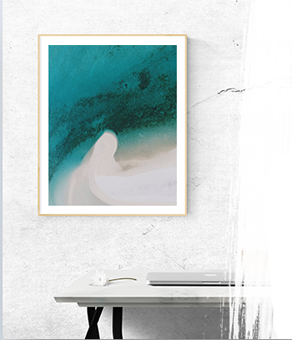6 Picture Framing Glass and Acrylic Types You Should Know By Tru Vue
What’s the Difference Between Glass vs. Acrylic for Picture Framing?
While glass and acrylic share many commonalities in terms of function, they are quite different in how they behave and in their applications. Each has its intended purpose, particularly when it comes to framing art and images, the environment in which they'll be displayed, and how they will be displayed. Chances are your framed pictures contain some of your most cherished memories, so it's extremely important to take into account how and where you'll be displaying them.
Glass, for instance, is much heavier and more easily shatters when compared to acrylic, so you may opt out of hanging it on the wall and instead prop it up on a table. Acrylic, on the other hand, Acrylic weighs less than half that of glass and is about 10 - 20 times stronger, you may opt for that if your art piece is already heavy and fragile.
While both can be glazed with various anti-reflective, anti-glare, and anti-UV ray options, not all glazes are equal and each has varying levels of protection. You can compare and contrast different glass and acrylic glaze properties here.

Most Popular Types of Picture Framing Glass:
Various glass types each have their own unique properties. Here are some of the most popular types of picture-framing glass that Tru Vue manufactures and their optimal applications:
- Museum Glass®: Tru Vue's Museum Glass is one of the best options because, well, you get museum-grade protection. Some of the largest galleries and museums in the world trust this glass to protect history's most priceless works of art. Its uncompromised protection and clarity ensure the image behind the glass never fades; and as a bonus, it's easy to clean! Its 2.5mm thickness offers better strength and rigidity than your basic, everyday picture frame glass, ensuring unparalleled clarity for years to come.
- AR Reflection-Free® Glass: AR Reflection-Free glass is the way to go if you plan on displaying your images in a sunlit area. This state-of-the-art technology eliminates virtually all glares and reflections so you can enjoy your images from across the room without visual noise. In addition to reflection elimination, this glass also filters 78% of UV rays, ensuring your image does not fade.
- Basic picture frame glass: Your basic picture frame glass, while protecting against everyday wear and tear elements, only has a 2.0mm thickness on average. Most basic picture frame glasses do not offer anti-reflective or UV protection properties. We do not recommend using basic picture frame glass to protect your most cherished memories.
Most Popular Acrylic Glass Options for Picture Framing:
Acrylic, as opposed to glass, has some different uses and properties. Here are some of the most popular types and applications of acrylic:
- Optium Museum Acrylic®: Like the Museum Glass, Optium Museum acrylic offers unrivaled levels of protection against glares, reflections, shattering, abrasions, and static. Acrylic, however, is much lighter than glass, so it offers even further opportunities for wall-hanging your most cherished memories. This acrylic is designed for permanence and does not require special cleaning treatment -- it cleans just like glass!
- Conservation Clear® Acrylic: While Conservation Clear acrylic doesn't offer the same level of protection against abrasions and static as Optium Museum acrylic, it does block 99% of UV rays and has shatter-proof safeguards in place. The word "conservation" in the name is no mistake -- this acrylic is perfect for keeping historic images in tip-top shape, especially in environments with heavy foot traffic or that are exposed to the elements.
- Standard Plexi-Glass: Standard plexiglass doesn't offer the same level of protection as any of the above two products, but it is fine for displaying images indoors so if you printed off photos from a family vacation that you can easily replace, standard plexiglass may be fine for you. But if you're trying to protect a once-in-a-lifetime image/document, you should go with one of the above options.
When Should I Use Acrylic Glass in Custom Framing Projects?
Acrylic is more flexible than glass products, so some of the most useful applications include:
- Framing/displaying fine art
- Displaying documents that are irreplaceable
- Original works of art and posters
- Images or artwork that has sentimental or monetary value
- Outdoor displays that may be exposed to the elements
- Family heirlooms/mementos
Other Factors to Consider
Whenever you're deciding between glass and acrylic (and their subtypes), it's important to truly understand your needs and the materials that are available. Here are some of the most crucial things that will guide your decision-making:
- Size of project
- Placement of the picture
- Environment and elements
- The sentimental or monetary value piece
Tru Vue: The Best Picture Framing Glass Options Made in the USA

Tru Vue provides tons of great glass and acrylic options for any situation -- whether you're displaying family photos or preserving priceless, irreplaceable heirlooms. Learn more about our comprehensive product line here, where we break down the characteristics of each, as well as their ideal applications.


















